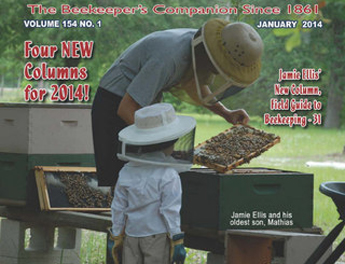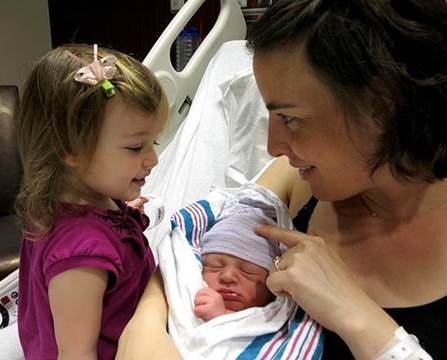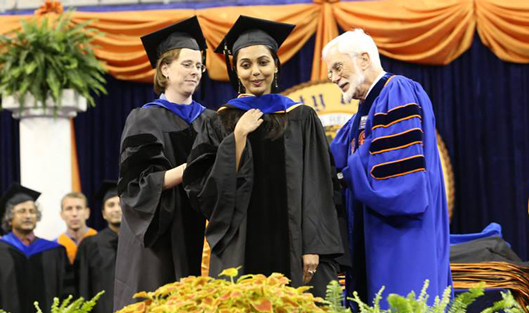- Faculty News
- Student News
- Lab News
- Publications
- Meetings and Presentations
- Outreach
- Grants
- Announcements
- About This Newsletter

ABOVE: Dr. Jamie Ellis has begun writing a column for the American Bee Journal entitled "Field guide to beekeeping." To introduce his new column the Journal made a picture of Jamie and his oldest son, Mathias, working a beehive the cover of the January issue.
PBS / NOVA blog: Digging Up Ants’ Evolutionary Origins covers some of the work being done by Dr. Andrea Lucky.

During the fall of 2013, Dr. Amanda Hodges and Project Co-PIs Ms. Stephanie Stocks and Dr. Stephen McLean (UF, DPM Alumni and UF Post-Doctoral Associate) successfully concluded a USDA-APHIS-PPQ Farm Bill 10201 Cooperative Agreement entitled "Delivery of Taxonomic Training through Distance Education."
As a component of the project, two intensive video-filmed workshops were hosted at the University of Florida on Aphididae and Coccoidea (May 2013) and Hemiptera: Auchenorrhyncha (August 2013). Mr. Joel Floyd, Domestic Diagnostics Coordinator for USDA-APHIS-PPQ; Dr. Greg Hodges, Bureau Chief for Entomology, Nematology, and Plant Pathology at FDACS-DPI; and Dr. Alma Solis, USDA-ARS-SEL Research Leader provided key overall co-coordination and leadership for the project during 2012-2013.
The videos featured expert lectures and hands-on training by Dr. Ian Stocks, FDACS-DPI; Dr. Greg Evans, USDA-APHIS-PPQ; Mr. John Dooley, USDA-APHIS-PPQ; Dr. Gary Miller, USDA-ARS-SEL; Dr. Susan Halbert, FDACS-DPI; Dr. Charles Bartlett, University of Delaware; Dr. Joe Eger, Dow Agrosciences; and Dr. Stuart McKamey, USDA-ARS-SEL.
The goal of the project was to provide engaging and interesting hands-on video tutorial for taxonomic groups that are important to USDA-APHIS-PPQ identifiers. The success of the project was highlighted in the annual USDA-APHIS-PPQ-NIS newsletter. Please note that some links listed in the newsletter are for internal communications and may not be available outside of USDA-APHIS-PPQ.
Several University of Florida, Entomology and Nematology staff members and students and Doctor of Plant Medicine students are featured in the videos (Tamika Garrick, David Sekora, Annika Minott, Carla Burkle, Eric LeVeen, Ashley Poplin, Gupreet Brar, Lyle Buss).
Stephanie Stocks is currently preparing the videos for public posting on YouTube. Stay tuned for more updates in future newsletters.

Welcome Toby Lucky to the Entomology & Nematology Family!

ABOVE: Bina, Toby, and Andrea. (Thank you for taking the picture, Jiri!)
Jiri and Andrea are happy to announce the arrival of Toby (Tobias) Lucky! He was born in the early morning on New Year’s day at 6 lbs 9 oz and was welcomed to the world by lots of celebration and fireworks.

Etymology. Compositermes vindai is named in honor of Boudanath (Vinda) Maharajh (1950-2009), who first joined our UF-based termite diversity survey team in 1996 in his homeland of Trinidad and Tobago. Vinda participated in another 23 expeditions until his last in 2008 to Venezuela. Vinda’s enthusiasm, collecting skills, and automobile driving style will not be forgotten.
Scheffrahn RH. 2013. Compositermes vindai (Isoptera: Termitidae: Apicotermitinae), a new genus and species of soldierless termite from the Neotropics. Zootaxa 3652(3): 381-391.
Congratulations to the 31 CALS students who were selected as Anderson Scholars for 2013. The award is named for James N. Anderson, who served as the first Dean of the College of Arts and Sciences (1910-1930), after whom Anderson Hall is named. This award is the highest recognition bestowed on students for their first two years of course work, and is a true mark of academic distinction for UF students. Each of these students earned a 3.90 GPA or higher over their first 60 credits. Students do not apply to become Anderson Scholars, the list is pulled automatically from student records.
Congratulations to Anderson Scholar Abigail Griffin, one of our Entomology & Nematology undergraduates!


ABOVE: Dr. Navneet Kaur (Ph.D.) successfully defended her graduate degree in December. She worked in the Buss Lab. The title of her dissertation is: Manipulating maintenance practices to reduce the susceptibility of two St. Augustinegrass cultivars to Blissus insularis Barber (Hemiptera: Blissidae). She is working on her manuscript submissions these days and looking forward to a post-doctoral study opportunity in future.
See the IFAS News Facebook page for more graduation photos!

M.S. student Ashley Poplin graduated in December 2013 with her thesis entitled "A Florida perspective on host preference, early detection, and identification of the brown marmorated stink bug, Halyomorpha halys (Stål)." Ashley Poplin was under the direction of Dr. Amanda Hodges. As Ms. Poplin was completing her degree, she accepted a position with Orange County Florida as a crime scene investigator.
Need to name that bug? A host of experts are available to help Floridians identify any insect or related arthropod. If a mystery creature has six or more legs, the UF Insect ID Lab is the place to call.
It was a busy year in the Insect Identification Lab. The lab processed 626 physical samples in 2013, which broke the previous record of 587 samples in 2012.

Lyle Buss is the Insect ID Lab manager.
 Think it might be a nematode problem? The Nematode Assay Laboratory serves Florida and other states by providing nematode assays and expert advice regarding nematode management.
Think it might be a nematode problem? The Nematode Assay Laboratory serves Florida and other states by providing nematode assays and expert advice regarding nematode management.
For more information on the Nematode Assay Laboratory please contact the lab manager Dr. Tesfa Mengistu.
Baidoo R, Stamps RH, Crow WT. 2013. Management of root-knot nematodes (Meloidogyne spp.) on Pittosporum tobira in Florida. Journal of Nematology 45: 281-282.
Cooper TM, Frank JH, Cave RD. 2014. Loss of phytotelmata due to an invasive bromeliad-eating weevil and its potential effects on faunal diversity and biogeochemical cycles. Acta Oecologica 54: 51-56.
Crow WT. 2013. Fluensulfone, a promising nematicide for use on turfgrasses. Journal of Nematology 45: 285-286.
Crow WT. 2013. The pathogenicity and interactions of Helicotylenchus pseudorobustus in Florida turfgrass systems. Journal of Nematology 45: 286.
Frank JH, McCoy ED. 2014. Zoogeography of mole crickets (Orthoptera: Gryllotalpidae) in the West Indies. Insecta Mundi 0331: 1-14.
Gu M, Crow WT. 2013. Effects of fungicides and insecticides on Belonolaimus longicaudatus. Journal of Nematology 45: 306.
Helmey-Hartman W, Miller C. 2014. Context-Dependent Mating Success in Murgantia histrionica (Hemiptera: Pentatomidae). Annals of the Entomological Society of America 107: 264-273.
Kakkar G, Kumar V, Nyoike T, Bardunias P. 2013. Traditional breeding programs for host plant resistance to insects are more productive and effective than transgenic programs. American Entomologist 59: 222-228.
Kokalis-Burelle N, Zasada I, Crow WT, LaMondia JA, Stetina SR, Westphal A. 2013. Navigating the publication process for the Journal of Nematology. Journal of Nematology 45: 299.
Kumar V, Kakkar G, Seal DR, McKenzie CL, Colee J, Osborne L. 2014. Temporal and spatial distribution of an invasive thrips species Scirtothrips dorsalis (Thysanoptera: Thripidae). Crop Protection 55: 80-90.
Luc JE, Crow WT. 2013. Factors affecting furfural as a nematicide on turf. Journal of Nematology 45: 260-264.
Lucky A, Trautwein MD, Guénard BS, Weiser MD, Dunn RR. 2013. Tracing the Rise of Ants - Out of the Ground. PLoS ONE 8(12): e84012. DOI: 10.1371/journal.pone.0084012
Miller CW, Svensson E. 2014. Sexual selection in complex environments. Annual Review of Entomology 59: 427-445.
Porter SD, Kumar V, Calcaterra LA, Briano JA, Seal DR. 2013. Release and establishment of little decapitating fly Pseudacteon cultallatus (Diptera: Phoridae) on imported fire ants (Hymenoptera: Formicidae) in Florida. Florida Entomologist 96: 1567-1573.
Seal DR, Kumar V, Kakkar G, Mello SC. 2013. Abundance of adventive Thrips palmi (Thysanoptera: Thripidae) populations in Florida during the first sixteen years. Florida Entomologist 96: 789-796.
Sekora D, Huffaker A, Crow WT, Mekete T. 2013. The effect of transgenic endogenous defense elicitors in Arabidopsis on the infection rate and life stage development of root-knot nematodes (Meloidogyne incognita). Journal of Nematology 45: 315.
 New on Featured Creatures:
New on Featured Creatures:
Two new Spanish translations! Both of these insects are biological controls used to manage Melaleuca, Melaleuca quinquenervia (Cav.) S.T. Blake (Myrtaceae) in south Florida.
Picudo de la melaleuca, Oxyops vitiosa (Pascoe)
and
Psílido, Boreioglycaspis melaleucae MooreSpanish Translation: Rodrigo Diaz, University of Florida; Ernesto Lasso de la Vega, Lee County Hyacinth Control District
We have several Featured Creatures pages in other languages.
These translations were provided by volunteers to help make Featured Creatures accessible to a wider audience. If you are interested in creating more translations (in the languages listed here or others), please contact us.
Do you have a favorite creature? Learn how to make it into a Featured Creature!
On December 4th, 2013, Dr. Billy Crow presented "Recognizing, diagnosing, and managing nematodes on golf courses in Ohio" at the annual meeting of the Ohio Turfgrass Foundation in Columbus, Ohio.
From the Outreach Coordinator
The live critters are always a hit with children and adults alike. The critters are available for you to check out should you be leading an outreach event. We have doubles of our most popular critters, as well as various native insect species depending on the time of year. We have large wood and Plexiglas cages for viewing our native orb weaving spiders. There is one travel cage and one larger static cage. Please be sure to contact us and review the protocol on transporting and handling the critters if you are not already familiar with it. If you lead an outreach, be sure to fill out a documentation form so your event can be included in the newsletter and we can log all outreach events.
If you would like to schedule an event or have any outreach questions, go to the Outreach pages on our Bug Club Website and contact us. I look forward to working with all of you over the next four years.
- Stephanie Stocks, Outreach Coordinator
- Office number 352-273-3958
 Getting social!
Getting social!
We have several social media sites for the Entomology & Nematology Department. To make them easily searchable, all three (YouTube, Facebook and Twitter) have the same page name: UFEntomology. Please share these links with past students or colleagues who may have an interest in departmental activities.
We like to share news when it happens using our social media outlets: Twitter, Facebook and YouTube. Follow us on these sites for daily updates! When you send news, we will post it on one or more of these sites and again in the monthly newsletter. Please be sure you have permission from people in photographs you submit for publication.
UF-Bugnews-L listserv subscribers receive notices when issues are posted. Our home page has instructions for subscribing and unsubscribing.
Special thanks to Dr. Verena Lietze and Nancy Sanders, who reviewed the newsletter for errors, and to Jane Medley and Don Wasik, who built the web page design.